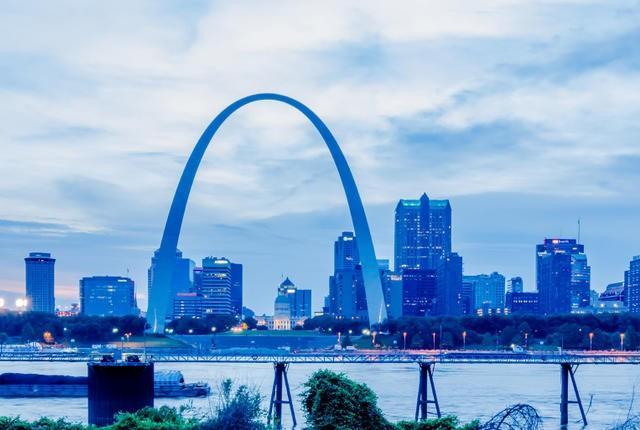At 630 feet, it's America’s tallest memorial, the Western Hemisphere’s tallest monument, and the world’s tallest arch. But the tribute to America’s westward growth didn’t rise into the Midwestern sky without overcoming a few hurdles. Here are a few facts about the Gateway Arch’s bumpy road from conception to construction, and beyond.
1. ST. LOUISANS DISAPPROVED OF PLANS FOR A MONUMENT.
America was in the thick of the Great Depression when St. Louis civic leader Luther Ely Smith approached the municipal government in 1933 with plans for a riverfront monument. Returning to St. Louis after a meeting about the George Rogers Clark Memorial in Indiana, of which he was on the commission, Smith felt a tribute to the westward expansion of the United States that began during Thomas Jefferson’s administration would really shine in his hometown.
Smith’s fellow citizens weren’t so sure of the plan. Many detractors insisted that government funds would be better spent on more practical projects for the struggling city. Citizens hoping to halt production on the monument approached every single member of Congress in 1936 with a counterargument in the form of a pamphlet titled, “Public Necessity or Just Plain Pork?” Smith couldn’t even rally the support of his family—his own daughter questioned the value of the symbolic project.
2. THE VOTE TO APPROVE THE PROJECT MAY HAVE BEEN RIGGED.
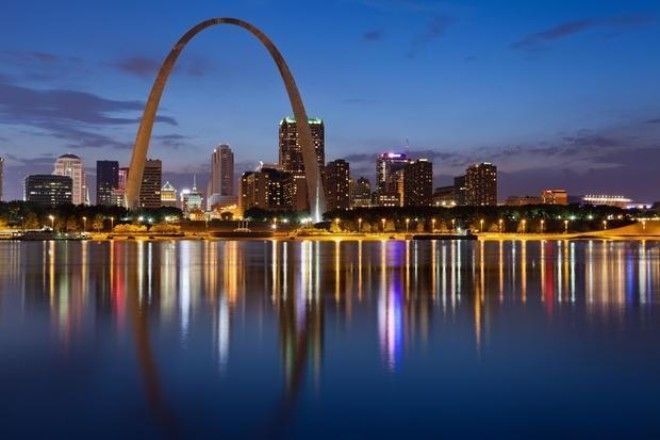
Two years later, the question was put to a vote: Would the city of St. Louis commit to a $7.5 million bond for the development of the Jefferson National Expansion Memorial? The positive outcome at the polls raised the suspicions of the St. Louis Post-Dispatch, whose reporting staff collected evidence suggesting a fixed vote.
Following the paper’s open accusation of criminal activity, a circuit court judge ruled that Missouri law only allowed for ballots to be opened in the case of candidate disputes, not in this situation. As such, the project was carried out as planned.
3. ACQUIRING LAND FOR THE PROJECT SPARKED A LEGAL DISPUTE.
By 1938, the Jefferson National Expansion Memorial Association had managed to condemn and demolish each building on the previously industrialized waterside site for the planned monument. However, a yearlong legal controversy slowed the project as remaining property owners questioned the legitimacy of JNEMA’s pursuit of the land. Ultimately, the United States Court of Appeals for the Eighth Circuit ruled in favor of the condemnation and demolition process’s legitimacy.
4. ONE MAJOR PUBLICATION DECRIED THE BUILDING OF THE MONUMENT.
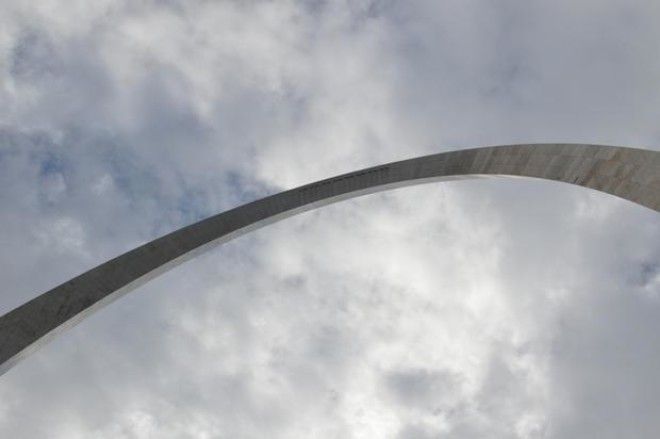
Journalist Paul W. Ward’s editorial in a February 1936 issue of The Nation came down hard on the Jefferson National Expansion Memorial. Ward called the endeavor “an audacious request” of government funds, “the furtherance of [administrators’] own petty ambitions,” and “the worst of all … projects that no self-respecting man would want to claim as his own.”
5. THE DESIGN OF THE ARCH STEMMED FROM TWO MEN PLAYING WITH A LINKED CHAIN.
Finnish-American industrial planner Eero Saarinsen crammed quite a few design achievements into his life, but what we now know as the Gateway Arch may be his most stunning achievement. Despite his massive talents, the architectural prodigy would still run into an occasional intellectual roadblock. Even after dreaming up the basic idea for the inverted catenary arch, Saarinsen had trouble figuring out how to imbue the monument with the “soaring” quality he was hoping for.
Saarinsen demonstrated his frustrations to German structural engineer Hannskarl Bandel with the visual aid of a drooping chain. Bandel convinced Saarinsen to lend him the chain in question for a few days and spent the period replacing a number of uniform links with ones of varying size. When this tweaked chain drooped, it had just the quality Saarinen was trying to capture.
6. THE ARCH CONCEPT HAD TO BEAT OUT A NUMBER OF COMPETING PROPOSALS.

Saarinen’s arch design was the victor of a 1947 design competition that yielded 172 different designs. Other entries included a sculpture depicting the signing of the Louisiana Purchase, animal statues, a riverside restaurant, an airport, an underwater subway system, several bridges and pylons, multiple abstract sculptures, and an arrangement of sizable frameworks to display alternating exhibits.
7. SAARINEN BEAT OUT HIS OWN FATHER FOR THE GRAND PRIZE.
Among the innovators to enter the competition was Eero Saarinen’s father, Eliel, a fellow architect renowned for his design of the Finnish Pavilion for the 1900 Paris World’s Fair. Eliel’s submission for the Jefferson National Expansion Memorial was a tall rectangular stone gate.
8. ANOTHER FAMOUS PAIR ALSO ENTERED THE COMPETITION.
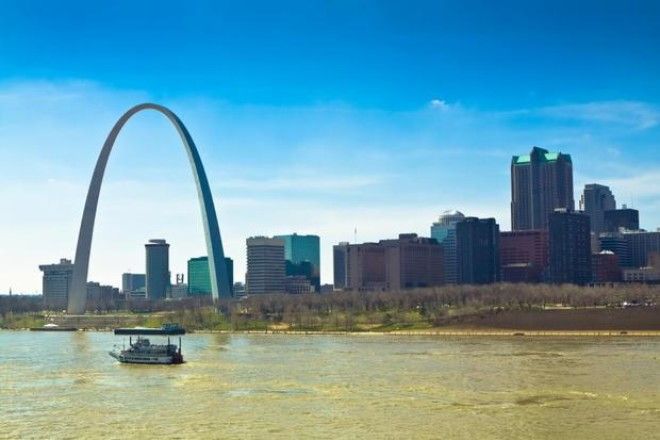
The sterling reputations of Charles and Ray Eames, award-winning pioneers of modern architecture in America and famous furniture designers, couldn’t help them in the anonymous competition. The Eames’s submission featured blueprints for an “information center” composed of a public park, amphitheater, museum, reference library, and series of sculptures. It was one of the first entries to be dismissed.
9. ACTIVISTS SCALED THE MONUMENT IN A CIVIL RIGHTS PROTEST.
New controversies blossomed during the Arch’s two-decade construction process. Civil rights activists took issue with the insufficient inclusion of skilled black laborers on the workforce responsible for building the Arch. One afternoon in July 1964, two activists—Percy Green and Richard Daly, representatives of the Congress of Racial Equality—took the opening of a lunch break to scale the 125-foot-high north leg of the unfinished monument and refused to descend for approximately four hours. The episode resulted in Green and Daly’s arrest, but led to the first “pattern or practice” lawsuit against St. Louis AFL-CIO Building and Construction Trades Council in pursuit of equal employment opportunity.
10. CONSTRUCTION ONLY REQUIRED TWO PERCENT OF ITS EXPECTED WORKFORCE.

One of the great promises of the original construction plan for the Arch was the opportunity for sustained employment for local laborers. Early development stages included predictions of creating more than 5000 jobs to bring the Arch to life. These numbers turned out to be hugely exaggerated: In the end, fewer than a hundred workers were called in to build the monument.
11. CONSTRUCTION WAS LESS DEADLY THAN EXPECTED.
While the Arch might have disappointed as a job creator, its safety record was a pleasant surprise. An actuarial firm assigned to assess the project predicted that construction would lead to 13 fatalities, but not a single life was lost on the job.
12. THE PROJECT’S GRAND OPENING WAS REPEATEDLY PUSHED BACK.

Although the monument was scheduled to open publicly in 1964, completion of the Gateway Arch took another year. Once the new “official” topping off date of October 17, 1965 rolled around, the monument was still deemed unfit for the world’s eyes. Eleven days later, the Arch was finally complete, but lingering issues kept it from being dedicated for three more years. The dedication ceremony with Vice President Hubert Humphrey on May 25, 1968 was robbed of much of its splendor by a tremendous downpour.
13. THE ARCH PAVED THE WAY FOR FUTURE ST. LOUIS PROJECTS.
The opening of the Arch and Busch Memorial Stadium only three blocks away jump-started St. Louis’s tourism industry with a vengeance and helped make a series of other new projects for the city possible, including apartment complexes, parking garages, hotels, and motels.
14. TEN PILOTS HAVE FLOWN THROUGH THE ARCH (ILLEGALLY).
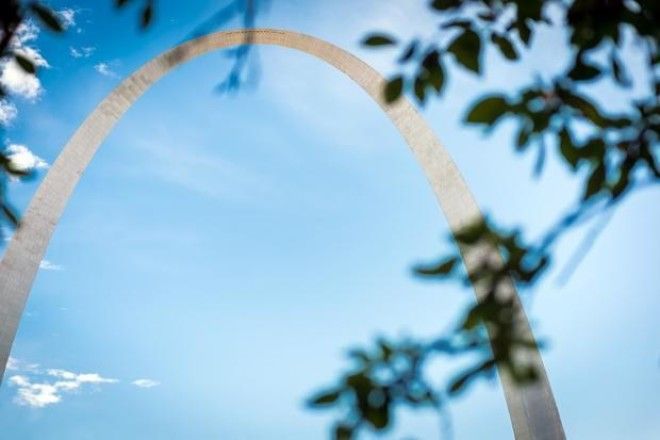
A total of nine airplanes—one in 1966, two in December 1969 (five days apart), one in April 1971, one in October 1971, one in November 1977 (without operating lights), one in January 1981, one in February 1981, and one in February 1982—and one helicopter in April 1984 have flown within the legs of the Gateway Arch. Even though such aerial antics are illegal, only the chopper pilot was apprehended.
15. THE ARCH IS THE SUBJECT OF AN OSCAR-NOMINATED FILM.
Renowned director and producer Charles Guggenheim detailed the story behind the Gateway Arch’s development in his 1967 documentary short Monument to the Dream. The film earned a nomination for Best Documentary Short at the 40th Academy Awards, but lost the prize to Trevor Greenwood’s ecologically inclined The Redwoods.
